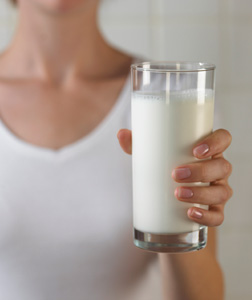The Harvard School of Public Health sent a strong message to the United States Department of Agriculture (USDA) and nutrition experts everywhere with the recent release of its “Healthy Eating Plate” food guide. The university was responding to the USDA’s new MyPlate guide for healthy eating, which replaced the outdated and misguided food pyramid.
Harvard’s nutrition experts did not pull punches, declaring that the university’s food guide was based on sound nutrition research and more importantly, not influenced by food industry lobbyists. The greatest evidence of its research focus is the absence of dairy products from the “Healthy Eating Plate” based on Harvard’s assessment that “…high intake can increase the risk of prostate cancer and possibly ovarian cancer.” The Harvard experts also referred to the high levels of saturated fat in most dairy products and suggested that collards, bok choy, fortified soy milk, and baked beans are safer choices than dairy for obtaining calcium, as are high quality supplements.
Category: MilkAndBones
High Calcium Snack: Puppodums
I first discovered puppodums in college through an Indian housemate. I thought they were nice, but I assumed they would be hard to find and laden with oil and calories like many Indian snacks.
I rediscovered these wonderful snacks at an oil free, dairy free, Indian cooking class.
Puppodums are similar to hard tortillas being made out of lentil and rice flour. You toast them over a stove or pop them in the microwave for 30 seconds which causes them to puff up. The result is something like a cross between a potato chip and popcorn with a pleasantly spicy taste.
During the class the empty box was passed around and I was pleasantly surprised to find out what a good deal puppodums are nutritionally. A serving has only 80 calories, but gives 6 grams of protein, 8% of the DV for Iron and 70% of the DV for calcium. The high calcium content is the result of lime being one of the ingredients.
A four ounce box, which gives you a generous amount of puppodums cost less than $3 at a Whole Foods.
I am certainly going to be eating more puppodums.
Raw Milk: Sickening Fashion

I remember as a child, my mother, an ex-fashionista, telling my older sister, a budding fashionista that what is old will be new again and that the fashions of yesterday would return to be the fashions of today.
The same thing seems to be true with diet fads.
The low carb diet, an obnoxious and unhealthy way to lose weight has been going in and out of style since it was invented by a 19th century undertaker.
Also recently revived from the 19th century, is an enthusiasm for drinking raw, unpasteurized milk. A significant health hazard.
Slate.com has an interesting article about the latest cycle of enthusiasm for drinking raw unpasteurized cow’s milk.
It was actually a German chemist, Franz von Soxhlet (who never seems to get any public credit or, of course, blame), who, in 1886, first proposed using the technique to reduce bacteria in bottled milk.* In the United States, public health advocates began urging dairy farmers to begin using pasteurization as a means of breaking down a near tidal wave of child mortality. Raw-milk followers, including our friend the irate physician, fought the move.
It wasn’t until 1914—compelled by a typhoid epidemic linked to unpasteurized milk—that New York City finally enforced a pasteurization rule. Seven years later, the city’s infant death rate, which had hovered at an appalling 240 of every 1,000 live births, had dropped to 71 deaths per 1,000, a victory many credited to pasteurization.
snip ….
Today, just about 0.5 percent of all the milk consumed in this country is unpasteurized. Yet from 1998 to 2008, the U.S. Centers for Disease Control and Prevention received reports of 85 infectious disease outbreaks linked to raw milk. In the past few months, physicians have treated salmonella in Utah, brucellosis in Delaware, campylobacter in Colorado and Pennsylvania, and an ugly outbreak of E. coli O157-H7 in Minnesota, which sickened eight people in June. Epidemiologists not only identified a rare strain of the bacteria but matched its DNA to those stricken, the cows on the farm that supplied them with raw milk, and manure smearing the milking equipment and even the animals themselves. When regulators shut down the dairy farm, supporters promptly charged them with belonging to a government conspiracy to smear the reputation of a hallowed food.
Some, like Wisconsin raw-milk champion Max Kane, dismiss infectious disease altogether: “The bacteria theory’s a total myth,” Kane told one interviewer. “It allows us to have an enemy to go after similar to how it is with terrorism. It’s food terrorism.”
After a dairy in Washington state was linked to an E. coli outbreak last December, the farmer himself put it like this in an interview with the Seattle Times. Scientists were wrong to malign his milk because “everything God designed is good for you.”
It seems an odd conclusion to draw from an outbreak of Escherichia Coli O157:H7, an organism dangerous enough to kill people by causing complete renal failure. I wish someone would explain the logic that leads to the conclusion that this apparently divine infection is actually “good for you.”

